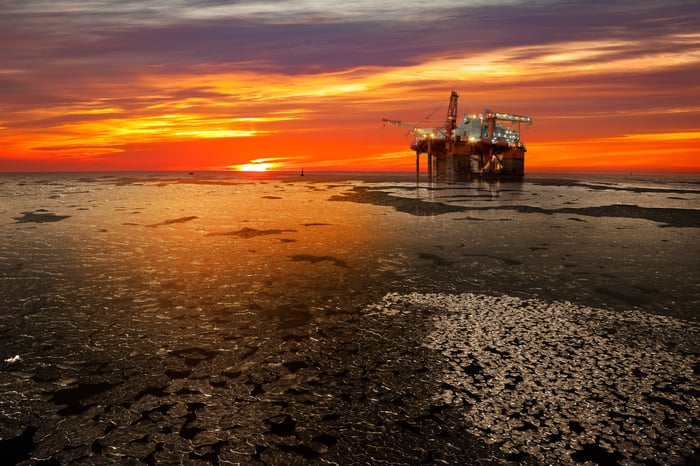At the moment, the world has more than enough oil to meet its needs. In fact, it has too much, which is why OPEC is holding back some of its production to drain off a portion of the excess crude sitting in storage depots around the world. Furthermore, according to an estimate from the International Energy Agency (IEA), the oil market will remain well supplied through at least 2020 even though demand should continue expanding at a brisk pace.
It's a different story post-2020, where there's a growing concern that the oil industry might not be able to keep up with continued demand growth because it's not reinvesting enough money into longer-term projects. That could result in a big shortfall in supplies, potentially fueling a significant spike in oil prices in the coming years.
The worst year ever
In its latest market report, the IEA pointed out that the oil industry only discovered 4 billion barrels of new oil resources last year. While that might sound like plenty, it fell well short of the 36 billion barrels consumed by the global economy last year. It was also a record low for the industry and followed up a similarly poor showing in 2016 when the industry found the fewest barrels in 70 years. Driving the dearth of discoveries is the fact that oil producers have significantly cut exploration spending in recent years.

Analysts are crunching the numbers and don't like what they see ahead. Image source: Getty Images.
While low oil prices played a major role in the discovery drop, a string of drilling expensive dry holes caused several explorers to abandon their efforts in recent years. One of the most notable failures was Royal Dutch Shell's (RDS.A) (RDS.B) big flop in the Arctic waters off Alaska. The big oil giant spent upwards of $7 billion to acquire leases and drill an exploration well only to come up dry. U.S. oil giant ConocoPhillips (COP -0.41%) also had big ambitions in the Alaskan Arctic, but they never got off the ground. Those failed exploration efforts were among many by ConocoPhillips in recent years, which also drilled a string of dry holes all across the Atlantic. The company decided to abandon its deepwater exploration efforts a few years ago.
An even bigger problem in the near term
The decline in discoveries in recent years could hurt the industry down the road. However, the more pressing issue is that oil companies have spent less money developing previous finds to meet medium-term global needs. The IEA noted that investment spending barely budged last year and will only be 6% higher this year. That level remains well below the peak before oil prices plunged a few years ago, and it's a concern because producers aren't spending very much of it on long-term projects that will boost supplies after 2020. That's leading the IEA to warn that the market might struggle to meet growing demand in the future.

Image source: Getty Images.
While the steep decline in the price of oil has driven the spending reduction, another issue is where oil companies have allocated capital. Instead off spending money on major long-term projects, companies like ConocoPhillips shifted the bulk of their investments into drilling shale wells in the U.S., which unleash a quick gusher of oil that they need to continually replace with new wells. While the exceptional returns on these wells enable companies to produce more oil for less money, they can't maintain that strategy forever, because they are rapidly depleting the inventory of prolific shale locations, which leads the IEA to believe that output from this resource will probably peak within a few years. The industry therefore needs to invest in more longer-term projects such as developing deepwater discoveries or new oil sands facilities because these assets deliver a steadier production rate.
The issue is that only a handful of oil giants are currently pursuing these long-term projects. ExxonMobil (XOM -0.09%) and Hess (HES 0.65%), for example, sanctioned the first phase of their offshore discovery in Guyana last year. The $3.2 billion project should produce 120,000 barrels per day when it comes online in 2020. Exxon and Hess have two more phases in development, which could ultimately produce 500,000 barrels per day. That development is part of ExxonMobil's big push to add 1 million barrels of oil equivalent per day of new production by 2025. While that will help, it's just a drop in the bucket for an industry that will need to produce more than 100 million barrels each day in the coming years.
Meanwhile, other projects take much longer to develop. For example, Canadian oil giant Suncor Energy (SU 0.42%) recently applied to build a new oil sands facility in the country. The 160,000-barrel-per-day Lewis project would cost CA$6.2 billion ($4.7 billion). However, Suncor Energy probably won't even break ground on construction until 2024 and wouldn't produce a drop of oil from it until 2027. That long lead time on large-scale projects is one of the reasons the IEA remains concerned about whether the industry can provide enough crude to meet demand in the early part of the next decade if shale output begins tapering off as anticipated.
Keep a close eye on this issue
While the world remains awash in oil right now, that might not be the case a few years from now. If oil demand grows as much as anticipated, there might not be enough fuel in the shale growth tank to both offset the decline of legacy wells and meet this growing need for crude. Oil companies therefore must start work now on longer-term projects that will come online around the time shale could run out of gas. If they wait too long, the world could find itself short of the fuel it needs, which could potentially cause another super-spike in crude prices. That's why investors with an eye toward the future should watch industry investment levels -- it could have significant future ramifications.





